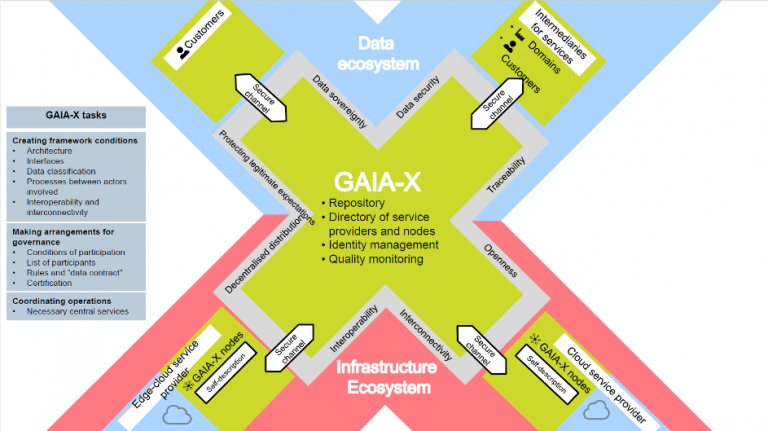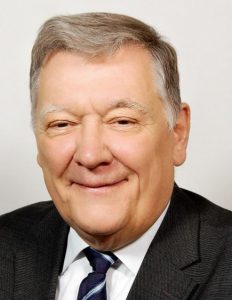This article gives a short overview of the Gaia-X (1) project as next generation cloud computing: with motivation for the project, what is Gaia-X?, project organization, role of civil society and prospects.
Motivation
Because of the CLOUD Act (Clarifying Lawful Overseas Use of Data Act, (2)), many users of cloud services from US cloud providers fear that personal data in Europe could be viewed, copied or modified by the US government in violation of the GDPR.
The demand for national data sovereignty has therefore grown in recent years, to which the German government has responded with the Gaia-X initiative of the Federal Ministry of Economics and Technology (BMWi) and the Federal Ministry of Education and Research (BMBF) as well as many companies from the IT environment (SAP, Telekom, Bosch, Siemens, and many more) and research institutions. Non-EU companies are also allowed to participate if they comply with European law.
On the one hand, Gaia-X should also be a European counterpart to American and Chinese hyperscalers (Amazon, Microsoft, Google, Alibaba, etc.), in which European law applies. On the other hand, after the German launch in October 2019, the European perspective has been added (3), initially with France.
At the beginning, BMWi and BMBF published a 50-page brochure “The Gaia-X Project – A networked data infrastructure as the cradle of a vital European ecosystem” (4), which describes the project. The aim is not to simply build the next hyperscaler with public funding, but to use standards to orchestrate many cloud solutions into an edge-cloud solution, ensuring that users can then combine individual solution components into a complete solution. The user can be sure that European law is applied, and the providers know about the security and the GDPR readiness of their offerings and the payment conditions. The participants in the project do this on their own account.

Fig. 1: A Federated Data Infrastructure as the Cradle of a Vibrant European Ecosystem (5)
In addition to the technical details, the brochure also provides a long list of possible fields of application. The topics are also assigned to sponsors who provide support or advice
- On the way to industry 4.0
- Practical implementation of industry 4.0
- Use synergies in supplier networks
- Secure and multifunctional cloud environment for the housing industry to generate smart living solutions with high latency requirements
- Financial Big Data Cloud – strengthening the German and European financial marketplace
- Artificial intelligence for clinical studies
- AI-based eTriage in the emergency room
- Better health care with “Smart Wearables” – how we can learn from data
- Citizen service around the clock: the chatbot in public administration
- Shaping the future city with Big Data from space
- Defeating cancer – a research cloud for genome data
- Data-based innovation: high performance and quantum computing “as a service
How these topics can benefit from the Gaia-X approach becomes clear when you take a closer look at the technical approach.
What is Gaia-X?
The following figure 1 shows the architecture of Gaia-X. It is not a monolithic, closed architecture (“vendor lock-in”), but an orchestration of a variety of cloud solutions and services. A user logs in to the repository where he can find a catalog of available solutions. These can be cloud services on different levels: IaaS, PaaS, SaaS, etc. The identity of the user and the services are secured. The quality of the services is ensured, and the service must describe itself online. Then the user can assemble his application set.
Imagine that you would own an airline. Then you could support your business with cloud technology:
Your airplanes constantly transmit IoT data to you worldwide, e.g. from their engines. Then your service company, but also the engine manufacturer, could permanently receive data. You could switch maintenance from fixed intervals to “on demand” at a lower cost, i.e. you could only service when necessary. You can share the IoT data with each other in an IaaS layer.
You operate an online booking system so that aircraft and passengers can book together for specific flights. This must be highly available 24*7 worldwide. For this purpose, you can use a PaaS cloud service with the highest requirements and fail-safe.
Now you also want to monitor all cash flows and book deposits and withdrawals in an enterprise resource planning solution (ERP) with additions for the logistics of your flight operations. This system can be operated via SaaS cloud services.
Ultimately, you want to analyze your large volumes of data automatically, with artificial intelligence or machine learning or simply with statistical analysis, e.g. with the R package. You can then run this software via another SaaS cloud service. You can analyze whether your marketing measures were successful or whether your flights flew with good capacity utilization and good contribution margin. You can monitor your aircraft to see if they need maintenance. The analysis doesn’t have to (but can) be done in real time, so the cloud facilities are only booked (and paid for) when they are needed.
This orchestration of cloud facilities for load-dependent use (peak load or periodic use) results in lower costs than a classic, in-house on-premise data center, which must be designed to meet the capital requirements of peak loads.
So, the benefit of Gaia-X for the user is that he can choose from a variety of standardized options, reduce his costs and store his data there, as required by his national legislation for security and data protection and compliance. Public companies can make even better use of commercial cloud offerings without having to build up their own cost-intensive cloud offerings. For providers, it is ideal to be able to sell their own offers via a platform with a high reach and also automatable.
Project Organization
The architecture described above is first of all a design, which is now to be brought to life within the Gaia-X project. For this purpose, there is a project management, which is supported by an advisory board, project support and communication. International activities are also coordinated from here.
There are two main groups of project teams: a) the user ecosystems and requirements and b) the technical implementation.
User ecosystems and requirements include:
- Industry 4.0 / SMEs
- Smart Living
- Finance
- Public Health
- Public Sector
- Energy Sector
The technical implementation is divided among others into:
- Architecture Board
- Software and Architecture
- Operational Infrastructure (to which also Cloudical belongs)
- Storage, Compute and Network
- Certification and Accreditation
From the end of 2019 to the end of 2020, a prototype is to be built in this highly complex environment. Milestones will be the Hanover Fair and assumption of the EU Council Presidency in mid-2020. The working groups will have a coordinating call at least every week and, depending on the shutdown, presence meetings. The more than 100 organizations are financed from their own resources without public subsidies.
The role of civil society
The composition of the stakeholders from administration, science and business is rather traditional, as has long been the case, for example, in the preparation of standards such as DIN. Some criticize that civil society is not represented in the project and cannot get involved.
It could provide additional impetus to help ensure the success of the project. For example, Gaia-X could be used to make open data available, such as the luftdaten.info (6) initiative of the Open Knowledge Lab Stuttgart for particulate matter in the air. Using simple sensors (available from 30 €), it now collects data in real time from hundreds of measuring points in Germany and beyond and publishes them immediately. Further measurements for other pollutant types are planned (NOx, etc.). These data could be made available to everyone in real time also in Gaia-X.
If standards are only created by the state and the economy, this can lead to problems. In the EU’s NextGEOSS (7) project, for example, which collects over 1.5 million data sets from EU satellites (photos, radar, laser and their metadata), government, business and civil society are working together. If existing standards have to be adapted (e.g. OpenSearch (8) has to be supplemented with spatial and time data in the metadata so that satellite photos can be localized), this is no longer done with DIN or ISO standards as in the INSPIRE world, but with open and free standards of the OGC (Open Geospatial Consortium (9)). The success of the rapid spread of the Internet was partly due to the fact that the standards (RFCs = Request for comment (10)) were available to everyone free of charge.
So, it should be considered how civil society could be introduced to Gaia-X more quickly, e.g. by participating in the project or through hackathons.
Prospects
Some observers are skeptical about the project. On the other hand, it is not another “me too” approach to build an European hyperscaler, but something completely new, a layer above the hyperscalers, so to speak, for orchestrating multi-cloud edge clouds. Even if the project failed, one would learn a lot of what is needed for the next generation of cloud computing. And that in the middle of Europe.
Cloudical is involved in the Gaia-X project in Workgroup 2 “Operational Infrastructure” (11), where Cloudical can contribute the most expertise from its daily business with cloud infrastructures. Cloudical is convinced that standards are necessary for multi-cloud strategies, on the one hand to enable providers to participate quickly in cloud orchestration, and on the other hand to enable users with such a meta platform to benefit greatly from orchestration of many cloud services.
(1) Gaia is the personified earth in Greek mythology and one of the first goddesses https://en.wikipedia.org/wiki/Gaia_(Mythologie)
(2) https://en.wikipedia.org/wiki/CLOUD_Act
(3) Ariane Rüdiger: Gaia-X should become a legally compliant European cloud – European, globally secure. iX 4/2020 p.84-89
(4) https://www.bmwi.de/Redaktion/EN/Publikationen/Digitale-Welt/project-gaia-x.html
(8) https://en.wikipedia.org/wiki/OpenSearch
(10) https://en.wikipedia.org/wiki/Request_for_Comments
(11) The Working Group “Operational Infrastructure” defines the physical and infrastructural criteria for the self-description of providers and nodes. Minimum requirements for data centres, networks and hardware will be defined here. These include sub-criteria such as sustainability, physical security and geographical assignment.

Author:
Wolfgang Ksoll is Senior Project Leader & Senior Business Development Leader at Cloudical Deutschland GmbH and works with Gaia-X.
Contact: wolfgang.ksoll@cloudical.io
